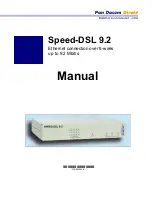
Page
24
RS
‐
232/485
RF
Modem
Product
Manual
–
MAN0782
‐
02
Streaming Mode
Attributes:
Highest data throughput
Lowest latency and jitter
Reduced immunity to interference
Streaming mode transmissions never acknowledged by receiving modem(s)
Required Parameter Values (TX Modem):
RR (Retries) = 0
Related Commands:
Networking (DT, MK, MY), Serial Interfacing (PK, RB, RO, TT)
Recommended Use:
Mode is most appropriate for data that is more sensitive to latency and/or
jitter than it is to occasional packet loss. For example: streaming audio or video.
Streaming Mode Connection Sequence
Figure
3.12.
Streaming
Mode
State
Diagram
When streaming data,
RB and RO parameters
are used only on the
first packet. After
transmission begins,
the TX event will
continue uninterrupted
until the DI buffer is
empty or the streaming
limit (TT Command) is
reached. As with the
first packet, the payload
of each subsequent
packet includes up to
the maximum packet
size (PK Command).
The streaming limit is
specified by the transmitting modem as the maximum number of bytes the transmitting modem
can send in one transmission event. If the TT parameter is reached, the transmitting modem will
force a random delay of 1 to RN delay slots (exactly 1 delay slot if RN=0).
Subsequent packets are sent without an RF initializer since receiving modems stay synchronized
with the transmitting modem for the duration of the transmission event (from preceding packet
information). However, due to interference, some receiving modems may lose data (and
synchronization to the transmitting modem), particularly during long transmission events.
Once the transmitting modem has sent all pending data or has reached the TT limit, the
transmission event ends. The transmitting modem will not transmit again for exactly RN delay
slots if the local (i.e. transmitting modem’s) RN parameter is set to a non-zero value. The
receiving modem(s) will not transmit for a random number of delay slots between 0 and (RN-1) if
the local (i.e. receiving modem’s) RN parameter is set to a non-zero value. These delays are
intended to lessen congestion following long bursts of packets from a single transmitting modem,
during which several receiving modems may have become ready to transmit.
Events up through the
‘Transmit Packet’
process are common to
all three RF
Communication Options.
Refer to the Transmit
Mode section [p 18] for
more information.
















































